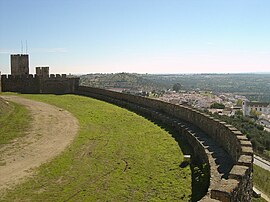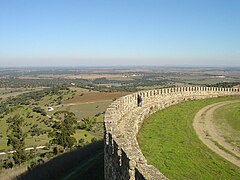world.wikisort.org - Portugal
Arraiolos (Portuguese pronunciation: [ɐʁɐˈjɔluʃ] (![]() listen)) is a municipality in Évora District in Portugal. The population in 2011 was 7,363,[1] in an area of 683.75 km2.[2] The town of Arraiolos has 3,351 inhabitants. The present Mayor is Silvia Pinto, elected by the Unitary Democratic Coalition.
listen)) is a municipality in Évora District in Portugal. The population in 2011 was 7,363,[1] in an area of 683.75 km2.[2] The town of Arraiolos has 3,351 inhabitants. The present Mayor is Silvia Pinto, elected by the Unitary Democratic Coalition.
Arraiolos | |
|---|---|
Municipality | |
 Arraiolos seen from the castle | |
 Flag  Coat of arms | |
 | |
| Coordinates: 38°43′N 7°59′W | |
| Country | |
| Region | Alentejo |
| Intermunic. comm. | Alentejo Central |
| District | Évora |
| Parishes | 5 |
| Government | |
| • President | Silvia Pinto (CDU) |
| Area | |
| • Total | 683.75 km2 (264.00 sq mi) |
| Population (2011) | |
| • Total | 7,363 |
| • Density | 11/km2 (28/sq mi) |
| Time zone | UTC±00:00 (WET) |
| • Summer (DST) | UTC+01:00 (WEST) |
| Local holiday | Ascension Day date varies |
| Website | http://www.cm-arraiolos.pt |
The town is famous for its castle and its embroidered wool rugs and carpets. Arraiolos rugs have been made since the Middle Ages.[3]
In October 2003, Jorge Sampaio, the then President of Portugal, invited the Presidents of Finland, Germany, as well as of soon-to-be EU members Hungary, Latvia and Poland to Arraiolos in order to discuss the consequences of the 2004 enlargement of the European Union and plans for a Constitution for Europe.[4] Subsequent meetings of non-executive presidents of European Union member states have been dubbed Arraiolos meetings.
History
A hoard of prehistoric objects, including a trapezoid-shaped plaque with geometric design and three pottery vessels, was excavated from a tumulus or barrow in Arraiolos at the beginning of the twentieth century. They are now kept at the British Museum.[5]
See also
- Vendas Novas for similar hoard
Parishes
Administratively, the municipality is divided into 5 civil parishes (freguesias):[6]
- Arraiolos
- Gafanhoeira e Sabugueiro
- Igrejinha
- São Gregório e Santa Justa
- Vimieiro
Notable people
- Joaquim Heliodoro da Cunha Rivara (1809 in Arraiolos – 1879 in Évora) a physician, professor, intellectual and politician
- Francisco José Caeiro (1890 in Vimieiro – 1976) a politician and former Minister and law professor.
Gallery
- A house in Arraiolos.
- The local castle.
- View of the countryside from the castle.
References
- Instituto Nacional de Estatística
- "Áreas das freguesias, concelhos, distritos e país". Archived from the original on 2018-11-05. Retrieved 2018-11-05.
- Fleming, John & Hugh Honour. (1977) The Penguin Dictionary of Decorative Arts. London: Allen Lane, p. 35. ISBN 0713909412
- "Foreign Policy Events, 13-20 October 2003". Ministry of Foreign Affairs (Latvia). Archived from the original on 9 December 2014. Retrieved 5 October 2013.
- British Museum Collection
- Diário da República. "Law nr. 11-A/2013, page 552 19" (pdf) (in Portuguese). Retrieved 16 July 2014.
External links
![]() Media related to Arraiolos at Wikimedia Commons
Media related to Arraiolos at Wikimedia Commons
На других языках
- [en] Arraiolos
[es] Arraiolos
Arraiolos es una villa portuguesa en el distrito de Évora, región Alentejo y comunidad intermunicipal de Alentejo Central, con cerca de 3500 habitantes.[ru] Аррайолуш
Аррайо́луш (порт. Arraiolos; [ɐʁɐi'ɔluʃ]) — посёлок городского типа в Португалии, центр одноимённого муниципалитета округа Эвора. Численность населения — 3,3 тыс. жителей (посёлок), 7,4 тыс. жителей (муниципалитет). Посёлок и муниципалитет входит в регион Алентежу и субрегион Алентежу-Сентрал. По старому административному делению входил в провинцию Алту-Алентежу.Другой контент может иметь иную лицензию. Перед использованием материалов сайта WikiSort.org внимательно изучите правила лицензирования конкретных элементов наполнения сайта.
WikiSort.org - проект по пересортировке и дополнению контента Википедии


